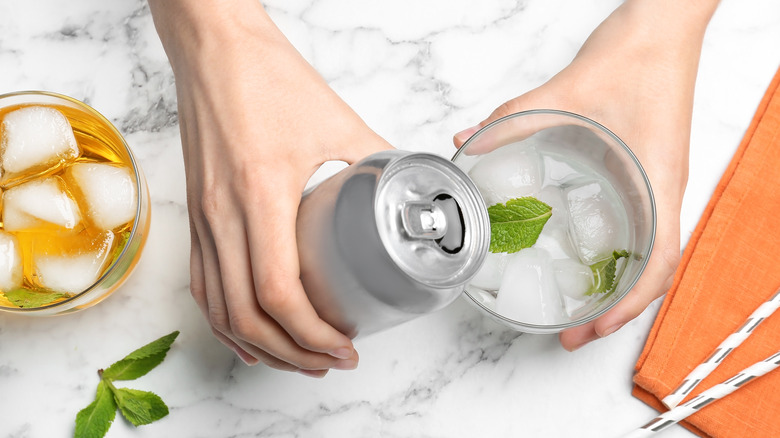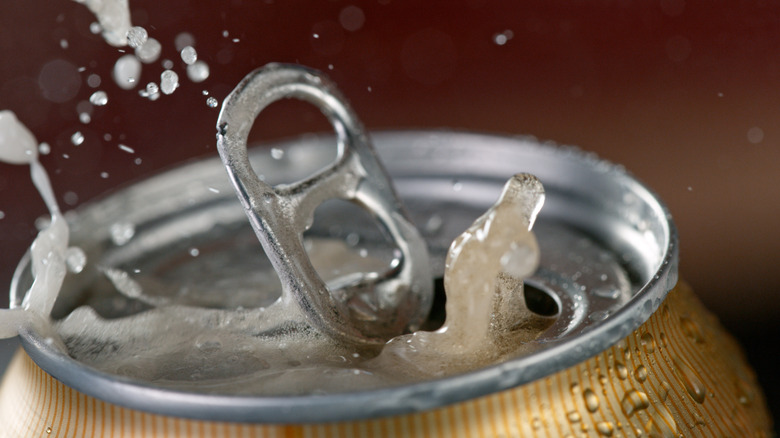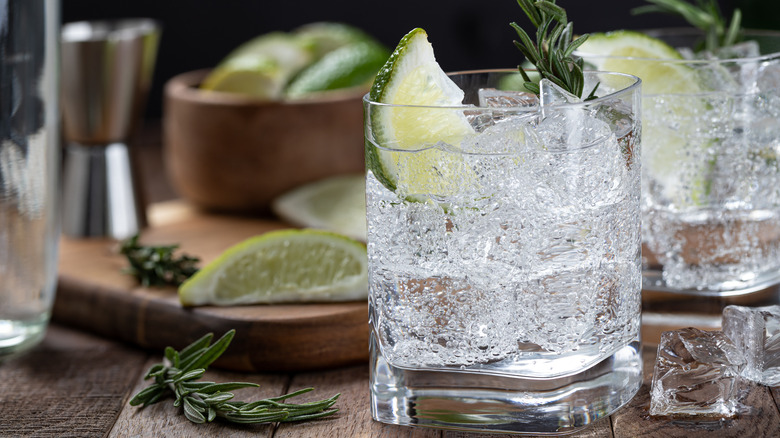Why It's So Difficult To Carbonate Canned Cocktails
Our innate love for bubbles begins at a young age when we're babies playing with soap suds in the bathtubs, mesmerized by their iridescent, spherical appearance, and carries through adulthood when we discover the joy of how they burst on the tongue in a gin and tonic or whisky highball. The ephemerality of bubbles adds to their unique appeal, but it is also part of what makes them so hard to capture in cans. For all that canned cocktails are convenient for consumers, they're enormously challenging for producers.
The carbonation level of a beverage is influenced by several factors, including temperature, pressure, and sugar levels. You may have noticed this while drinking a bubbly beverage — which goes flat as time passes and the liquid warms up — but these factors are also important during the production process.
Carbonation occurs when carbon dioxide (CO2) is introduced into a liquid. For this to happen, the liquid must be very cold — otherwise, the C02 will not dissolve. The sugar content of the liquid also affects the process. A high quantity of sugar can cause the liquid to become more viscous and therefore more difficult to carbonate. For this reason, the sweetness of some alcohols and mixers can prove problematic — which means it's difficult for canned cocktails to have that sparkle you might expect.
How bubbly beverages are made
Beverages can be carbonated according to two different techniques: bottled carbonation or forced carbonation. The former method is used for making champagne and takes place over the course of months or even years by introducing yeast into the bottle, which eventually naturally releases carbon dioxide. The latter method is used for a broader range of fizzy drinks, including canned cocktails, and speeds up the carbonation process by infusing CO2 directly into a liquid with specialized equipment. While the forced carbonation approach is significantly faster, it creates the added challenge of transferring the carbonated liquids from a large tank to individual containers for consumers, which must be done with specific pumps and pressurized chambers.
If you're wondering why we go to such lengths for bubbly beverages, it's useful to know that carbonation can significantly affect your drinking experience, including how you perceive texture and flavor. The greater the amount of CO2 in a drink, the more extreme the tickly or scratchy feeling of effervescence is on your tongue. This also adds a more acidic taste. Less CO2 results in a smoother, milder consistency and flavor. Getting the right balance is imperative to enhance the experience of each drink — but this takes time (and product) to experiment thoroughly.
Tips for enjoying carbonated cocktails at home
The canned cocktail industry may be expanding and improving, but if you're still having trouble finding your favorite effervescent drink on supermarket shelves, and you're ready for a deep dive into the science behind mixology, it might be time to learn how to carbonate cocktails at home. By carbonating the entire cocktail, rather than using just a single carbonated ingredient — such as tonic water or sparkling wine — you can enjoy an even more intensely bubbly drinking experience.
However, if you're not ready to invest in a personal carbonation system, there are plenty of ways to optimize classic carbonated beverages, like an Americano cocktail, Moscow mule, or Tom Collins. For example, you can batch them with plain club soda for parties – just keep in mind the rule you shouldn't break when preparing fizzy batch cocktails: Add the carbonated ingredient just before serving. You can prepare the other elements of the drinks in advance, but wait to mix in this final element at the last second to avoid offering your guests something that has prematurely gone flat. When it's nearly time to toast, be sure to try the cocktail spoon trick to pour better fizzy drinks. Guiding the liquid from the shaker to the glass with this long stirring utensil helps prevent the cocktail from bubbling up too much and spilling over the rim.



